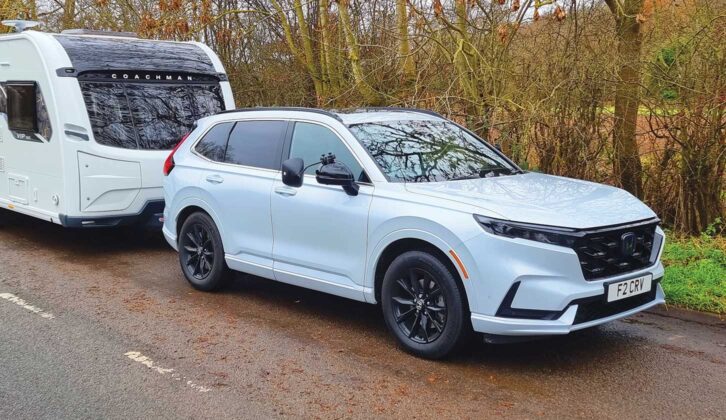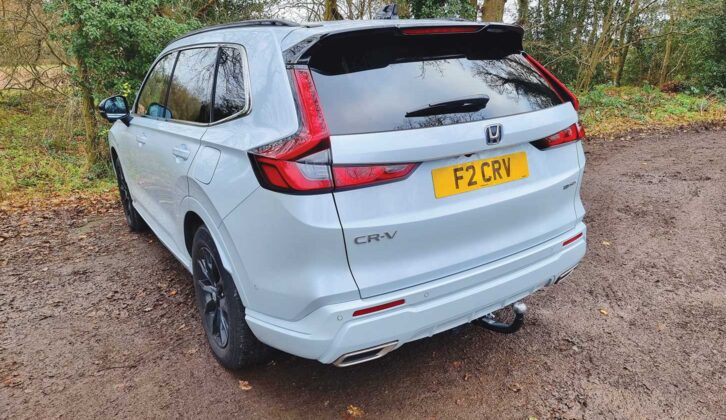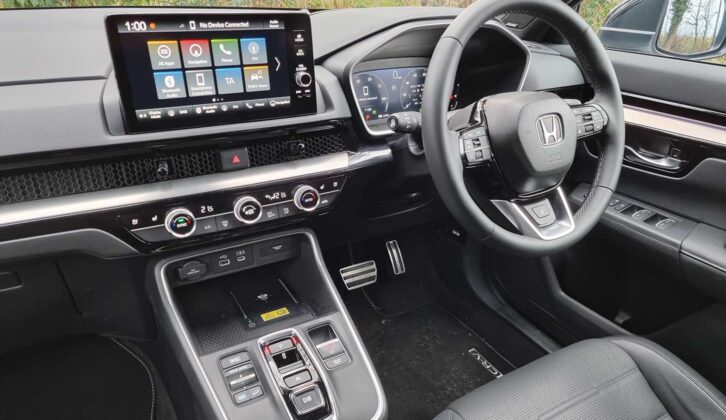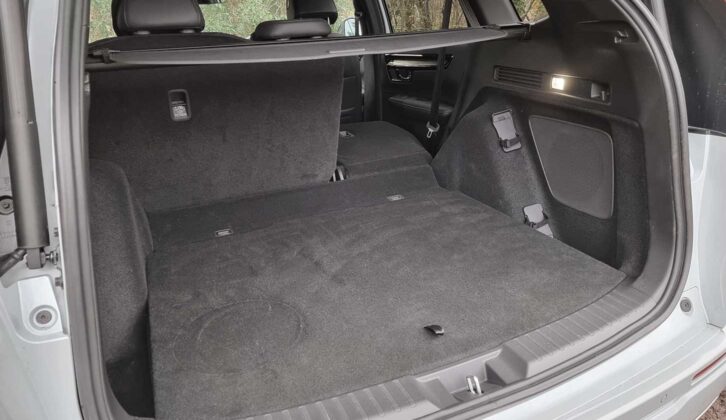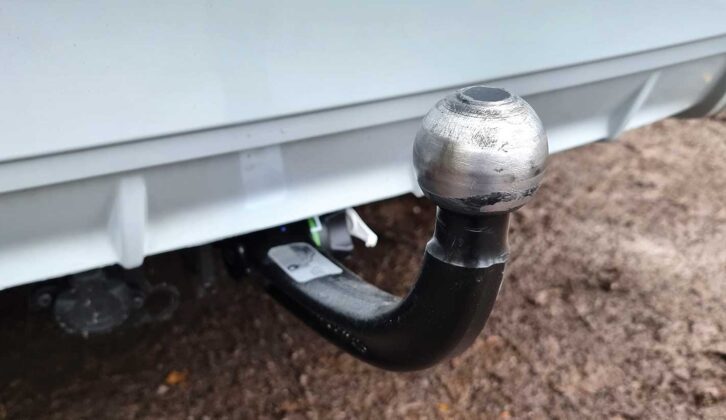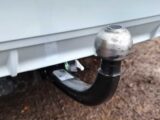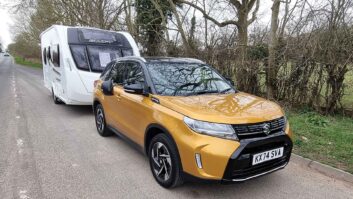Verdict
Rear headroom aside, the CR-V is a very practical family SUV. However, it’s a shame there’s no four-wheel-drive plug-in hybrid, and the Honda can be noisy while towing.
Pros
- Comfortable
- Good boot space by plug-in hybrid standards
Cons
- Can be noisy when towing
- No four-wheel-drive plug-in available
This is the sixth generation of the Honda CR-V. It’s bigger than the old model, packed with high-tech features, and offers a choice of hybrid and plug-in hybrid drivetrains. Here, we’re testing the plug-in version in Advance Tech specification.
What are we looking for in the Honda CR-V 2.0 Plug-in Hybrid 2WD Advance Tech?
We want to find out how well the new Honda tows, and if it can justify a price tag of well over £50,000.
Towing ability of the Honda CR-V 2.0 Plug-in Hybrid 2WD Advance Tech
Plug-in hybrids tend to be heavy, thanks to the combined weight of the petrol and the electrical components. However, the towing limits can be quite modest.
Honda quotes a kerbweight of 1923kg for the CR-V plug-in hybrid tow car, and a maximum towing figure of 1500kg, which is some way below an 85% match. However, it’s a huge improvement over the 750kg maximum of the CR-V full hybrid.
Oddly, the full hybrid is four-wheel drive, but the plug-in hybrid only sends power to the front wheels, which is unusual for an SUV for towing at this price point.
The big jump in the maximum towing figure between the two models is down to the plug-in’s towing mode. Honda says the towing setting “keeps the engine revs low with a low gear ratio lock-up clutch and battery assist when towing uphill”. In practice, the towing setting prioritises the petrol engine over the electric motor.
We matched the Honda to a Coachman VIP 565 with a MiRO of 1487kg, just within the maximum towing figure.
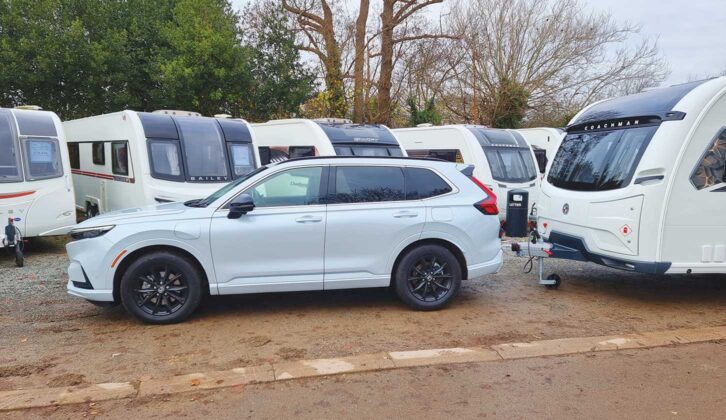
When the CR-V’s petrol engine directly drives the car, rather than acting as a generator for the electric motor, it has just two forward gears. This makes for a rather odd experience while towing.
Driving at a steady 60mph (see: the speed limits when towing a caravan if you want a refresh on this), the vehicle is alternately buzzing like a chainsaw or going along quietly, depending on the engine load and the gradient.
The car also struggled with a hill start on damp Tarmac – acceleration was laboured at first on the 1-in-10 slope, with the Honda spinning its wheels if required to move with more urgency.
One of the traits we look for in the best caravan tow cars is stability. In the case of the CR-V, it is stable and composed on country roads while towing a tourer. Driven on busy motorways, the Honda mostly feels secure, but you do notice the caravan pulling at the back of the car in the disturbed air around HGVs and coaches.
Solo driving the Honda CR-V 2.0 Plug-in Hybrid 2WD Advance Tech
Switch out of towing mode and leave the caravan on its pitch, and the CR-V is more conventional to drive. There’s rarely any need for the engine to rev hard, especially in town, where it is quiet and smooth.
Matching the official range (up to 50 miles) requires a light right foot and warm weather. But even in winter, the average commute can be tackled on battery power alone.
The plug-in CR-V comes with adaptive dampers as standard. Choose the ‘normal’ drive mode and the suspension does a fine job of smoothing over speed bumps and potholes, without allowing the car to float or wallow at higher speeds.
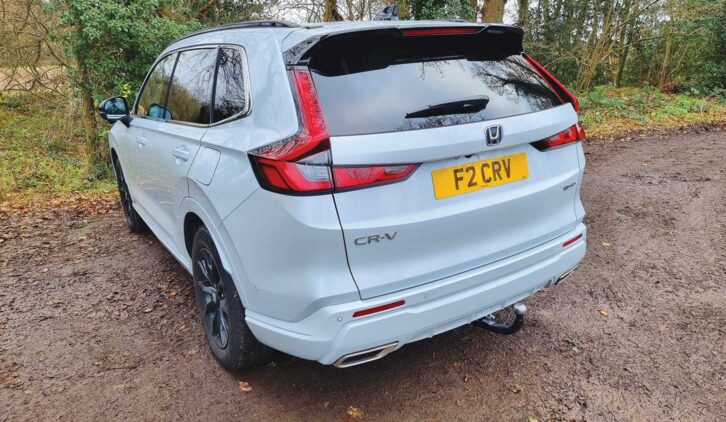
‘Sport’ mode firms things up, but this never feels like a sporty car to drive. Honda quotes a 0-62mph time of 9.2 seconds, so it’s not desperately quick, either. There are plenty of more driver-focused SUVs at this price point, not least the BMW X3.
For anyone who prefers a more sedate pace, the CR-V is very comfortable. A little less road noise would make it even better.
Space and practicality in the Honda CR-V 2.0 Plug-in Hybrid 2WD Advance Tech
Honda has ignored the trend to minimise dashboard buttons in favour of touchscreen menus, and ease of use is all the better for it. Adjusting temperature or fan speed is quick and easy using separate controls.
The infotainment screen is easy enough to use, although it looks a little dated next to the higher-res screens in some rivals.
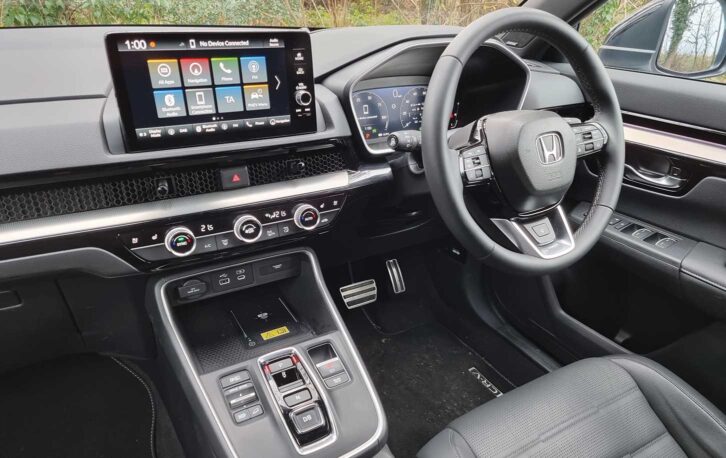
Drivers have plenty of adjustment to the seat and wheel, so most shapes and sizes can be accommodated. At first glance the back seats look very nearly as comfortable, with acres of legroom and an almost-flat floor. But the panoramic sunroof steals a lot of headroom. On the other hand, the doors open unusually wide, which makes it easy to lift a child into their car seat.
The boot holds a generous 617 litres, especially impressive when you think how many plug-ins have compromised boots to make room for the batteries.
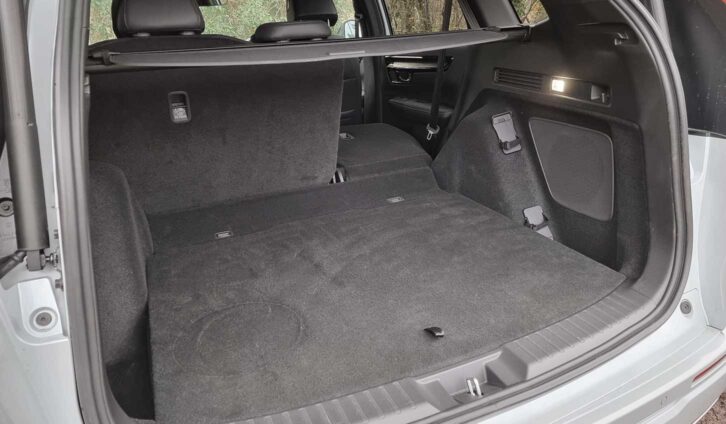
The rear seats fold to give more space, although this does leave a step to the floor. There’s room underneath for storing the charging cables. Throughout the cabin, the CR-V feels solidly screwed together, but the materials used lack the premium finish you’d hope for at this price.
Buying and owning a Honda CR-V 2.0 Plug-in Hybrid 2WD Advance Tech
The plug-in hybrid CR-V comes in one specification, Advance Tech. It’s generously equipped with a multiview camera system, front and rear parking sensors, a head-up display, wireless phone charging, heated seats front and rear, a heated steering wheel and 18-inch alloys. There’s also a comprehensive suite of driver assistance systems, called Honda Sensing 360.
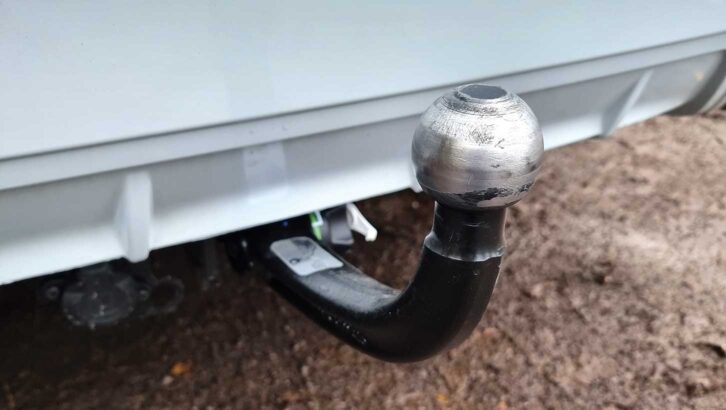
Even with a long list of kit, the £53,995 price tag is steep. It puts the CR-V in competition with prestige models on the one hand, and mainstream seven-seaters on the other. Running costs should be low so long as you can recharge regularly, with an official combined figure of 353mpg. We saw a disappointing 21mpg while towing.
Alternatives to consider
The Volvo XC60 Recharge Plug-in Hybrid T6 AWD Plus is a capable option to consider, offering stability and space. Alternatively, the Volkswagen Touareg 13.0 V6 TDI 286PS 4Motion Black Edition is a stable SUV, providing everything a large SUV should offer.
If you’d be interested in a pre-owned CR-V, see what we had to say about buying a used Honda CR-V (2016-22), which should tow well so long as you opt for the diesel version.
Technical spec
- Price: £53,995
- What Car? Target Price: £51,637
- Retained value after three years: 52%
- Kerbweight: 1923kg
- 85% of kerbweight: Above max tow
- Gross vehicle weight: 2430kg
- Max towing limit: 1500kg
- Gross train weight: 3930kg
- Towball limit: 100kg
- Price of towball and electrics: £925
- Boot size: 617-1710 litres
- Payload: 507kg
- Test conditions: Damp
- Engine size: 1993cc
- Power (hp): 148 (petrol)/ 184 (electric)
- Torque (lb ft): 139 (petrol)/247 (electric)
- Official combined economy: 353mpg
- Towing economy: 21mpg
- CO2 emissions: 18g/km
- 1st/2nd year car tax: £0/£560
- Insurance group: 37
- Euro NCAP rating: TBC
Looking for a way to keep your tow car safe? Take a look at our best steering wheel lock guide to see our top picks on the market.
If you’ve enjoyed reading this article, why not get the latest news, reviews and features delivered direct to your door or inbox every month. Take advantage of our brilliant Practical Caravan magazine SUBSCRIBERS’ OFFER and SIGN UP TO OUR NEWSLETTER for regular weekly updates on all things caravan related.
Technical Specifications
| Engine Size | 1993 cc |
| Kerbweight | 1923 kg |
| 85% KW | Above max tow kg |
| Towball Limit | 100 kg |
| Maximum Towing Limit | 1500 kg |
| Power | 148 (petrol)/ 184 (electric) bhp |
| Torque | 139 (petrol)/ 247 (electric) lb ft |
| Offical MPG | 353 mpg |
| Towing MPG | 21 mpg |
| CO₂ | 18 g/km |
